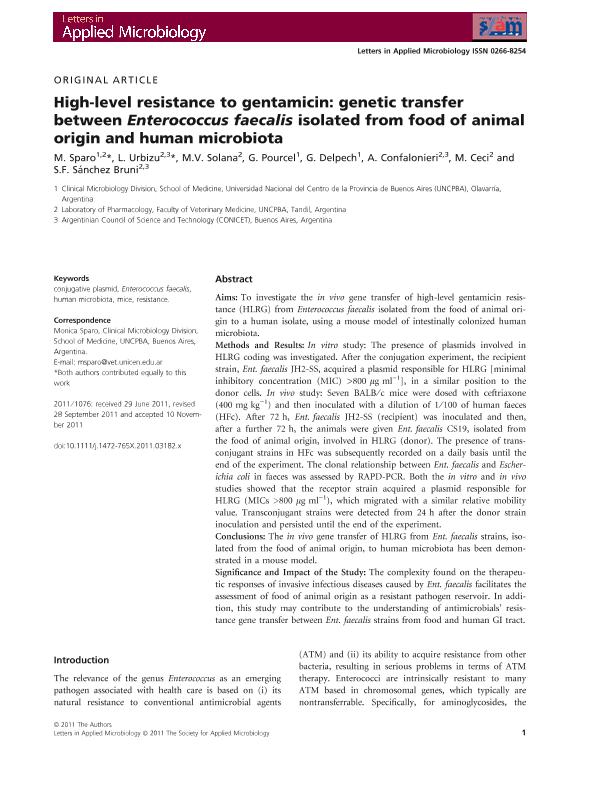Mostrar el registro sencillo del ítem
dc.contributor.author
Sparo, Mónica Delfina

dc.contributor.author
Urbizu, Lucia Paola

dc.contributor.author
Solana, María Victoria

dc.contributor.author
Pourcel, Natalia Gisela

dc.contributor.author
Delpech, Gastón

dc.contributor.author
Confalonieri, Alejandra

dc.contributor.author
Ceci, M.
dc.contributor.author
Sanchez Bruni, Sergio Fabian

dc.date.available
2018-12-26T19:24:41Z
dc.date.issued
2012-02
dc.identifier.citation
Sparo, Mónica Delfina; Urbizu, Lucia Paola; Solana, María Victoria; Pourcel, Natalia Gisela; Delpech, Gastón; et al.; High-level resistance to gentamicin: Genetic transfer between Enterococcus faecalis isolated from food of animal origin and human microbiota; Wiley Blackwell Publishing, Inc; Letters in Applied Microbiology; 54; 2; 2-2012; 119-125
dc.identifier.issn
0266-8254
dc.identifier.uri
http://hdl.handle.net/11336/66997
dc.description.abstract
Aims: To investigate the in vivo gene transfer of high-level gentamicin resistance (HLRG) from Enterococcus faecalis isolated from the food of animal origin to a human isolate, using a mouse model of intestinally colonized human microbiota. Methods and Results: In vitro study: The presence of plasmids involved in HLRG coding was investigated. After the conjugation experiment, the recipient strain, Ent. faecalis JH2-SS, acquired a plasmid responsible for HLRG [minimal inhibitory concentration (MIC) >800μgml -1], in a similar position to the donor cells. In vivo study: Seven BALB/c mice were dosed with ceftriaxone (400mgkg -1) and then inoculated with a dilution of 1/100 of human faeces (HFc). After 72h, Ent. faecalis JH2-SS (recipient) was inoculated and then, after a further 72h, the animals were given Ent. faecalis CS19, isolated from the food of animal origin, involved in HLRG (donor). The presence of transconjugant strains in HFc was subsequently recorded on a daily basis until the end of the experiment. The clonal relationship between Ent. faecalis and Escherichia coli in faeces was assessed by RAPD-PCR. Both the in vitro and in vivo studies showed that the receptor strain acquired a plasmid responsible for HLRG (MICs >800μgml -1), which migrated with a similar relative mobility value. Transconjugant strains were detected from 24h after the donor strain inoculation and persisted until the end of the experiment. Conclusions: The in vivo gene transfer of HLRG from Ent. faecalis strains, isolated from the food of animal origin, to human microbiota has been demonstrated in a mouse model. Significance and Impact of the Study: The complexity found on the therapeutic responses of invasive infectious diseases caused by Ent. faecalis facilitates the assessment of food of animal origin as a resistant pathogen reservoir. In addition, this study may contribute to the understanding of antimicrobials' resistance gene transfer between Ent. faecalis strains from food and human GI tract.
dc.format
application/pdf
dc.language.iso
eng
dc.publisher
Wiley Blackwell Publishing, Inc

dc.rights
info:eu-repo/semantics/openAccess
dc.rights.uri
https://creativecommons.org/licenses/by-nc-sa/2.5/ar/
dc.subject
Conjugative Plasmid
dc.subject
Enterococcus Faecalis
dc.subject
Human Microbiota
dc.subject
Mice
dc.subject
Resistance
dc.subject.classification
Otras Ciencias de la Salud

dc.subject.classification
Ciencias de la Salud

dc.subject.classification
CIENCIAS MÉDICAS Y DE LA SALUD

dc.title
High-level resistance to gentamicin: Genetic transfer between Enterococcus faecalis isolated from food of animal origin and human microbiota
dc.type
info:eu-repo/semantics/article
dc.type
info:ar-repo/semantics/artículo
dc.type
info:eu-repo/semantics/publishedVersion
dc.date.updated
2018-09-18T16:16:52Z
dc.journal.volume
54
dc.journal.number
2
dc.journal.pagination
119-125
dc.journal.pais
Reino Unido

dc.journal.ciudad
Londres
dc.description.fil
Fil: Sparo, Mónica Delfina. Universidad Nacional del Centro de la Provincia de Buenos Aires; Argentina
dc.description.fil
Fil: Urbizu, Lucia Paola. Universidad Nacional del Centro de la Provincia de Buenos Aires. Facultad de Ciencias Veterinarias; Argentina. Consejo Nacional de Investigaciones Científicas y Técnicas; Argentina
dc.description.fil
Fil: Solana, María Victoria. Universidad Nacional del Centro de la Provincia de Buenos Aires. Facultad de Ciencias Veterinarias; Argentina. Consejo Nacional de Investigaciones Científicas y Técnicas; Argentina
dc.description.fil
Fil: Pourcel, Natalia Gisela. Universidad Nacional del Centro de la Provincia de Buenos Aires; Argentina
dc.description.fil
Fil: Delpech, Gastón. Universidad Nacional del Centro de la Provincia de Buenos Aires; Argentina. Consejo Nacional de Investigaciones Científicas y Técnicas; Argentina
dc.description.fil
Fil: Confalonieri, Alejandra. Universidad Nacional del Centro de la Provincia de Buenos Aires. Facultad de Ciencias Veterinarias; Argentina. Consejo Nacional de Investigaciones Científicas y Técnicas; Argentina
dc.description.fil
Fil: Ceci, M.. Universidad Nacional del Centro de la Provincia de Buenos Aires. Facultad de Ciencias Veterinarias; Argentina
dc.description.fil
Fil: Sanchez Bruni, Sergio Fabian. Universidad Nacional del Centro de la Provincia de Buenos Aires. Facultad de Ciencias Veterinarias; Argentina. Consejo Nacional de Investigaciones Científicas y Técnicas; Argentina
dc.journal.title
Letters in Applied Microbiology

dc.relation.alternativeid
info:eu-repo/semantics/altIdentifier/doi/http://dx.doi.org/10.1111/j.1472-765X.2011.03182.x
dc.relation.alternativeid
info:eu-repo/semantics/altIdentifier/url/https://onlinelibrary.wiley.com/doi/full/10.1111/j.1472-765X.2011.03182.x
Archivos asociados
